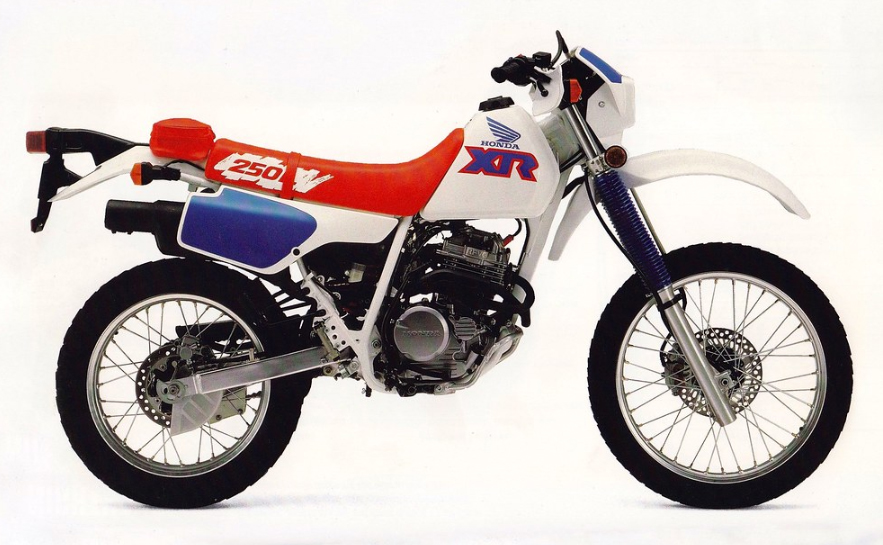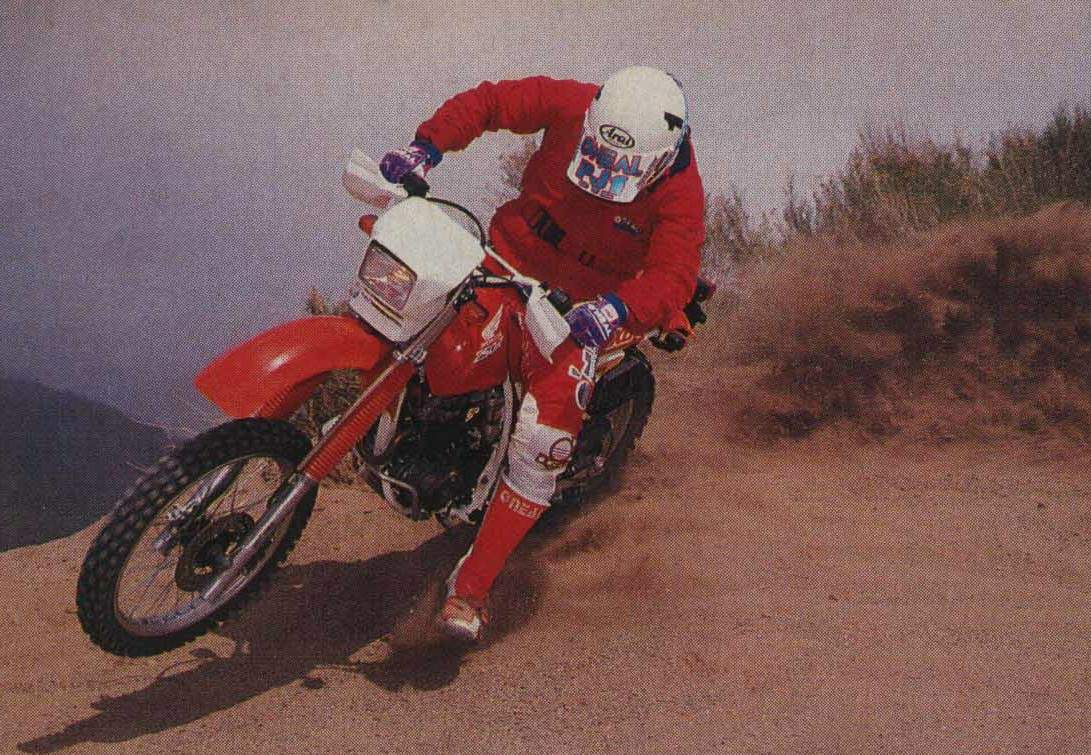
|
|
|
|
|
|
Classic Bikes
Custom Bikes
Individual
Racing Bikes AJP
AJS
Aprilia
Ariel
Avinton / Wakan
Bajaj
Benelli
Beta
Bimota
BMW
Brough Superior
BRP Cam-Am
BSA
Buell / EBR
Bultaco
Cagiva
Campagna
CCM
CF Moto
Combat Motors
Derbi
Deus
Ducati
Excelsior
GASGAS
Ghezzi Brian
Gilera
GIMA
Harley Davidson
Hero
Highland
Honda
Horex
Husaberg
Husqvarna
Hyosung
Indian
Jawa
Kawasaki
KTM
KYMCO
Laverda
Lazareth
Magni
Maico
Mash
Matchless
Mondial
Moto Guzzi
Moto Morini
MV Agusta
MZ / MuZ
NCR
Norton
NSU
Paton
Peugeot
Piaggio
Revival Cycles
Roland Sands
Royal Enfield
Sachs
Sherco
Sunbeam
Suzuki
SWM
SYM
Triumph
TVS
Ural
Velocette
Vespa
Victory
Vincent
VOR
Voxan
Vyrus
Walt Siegl
Walz
Wrenchmonkees
Wunderlich
XTR / Radical
Yamaha
Zero
Video
Technical
Complete Manufacturer List
|
Honda XR 250L
|
| . |
|
Make Model |
Honda XR 250L |
|
Year |
1991 - 92 |
|
Engine |
Four-stroke, single cylinder SOHC, 4 valve |
|
Capacity |
249 cc / 15.1 cu-in |
| Bore x Stroke | 73 x 59.5 mm |
| Cooling System | Air cooled |
| Compression Ratio | 9.3:1 |
|
Induction |
30 mm Keihin |
| Ignition | CDI |
| Spark Plug | NGK DPR8z |
| Battery | YTX4L-BS -12 volt |
|
Starting |
Kick or Electric |
|
Max Power |
30 hp / 21.9 kW @ 9000 rpm |
|
Max Torque |
24.5 Nm / 18.7 ft. lbs @ 7500 rpm |
|
Transmission |
6 Speed |
| Final Drive | Chain |
| Gear Ratio | 1st 2.769 : 1 2nd 1.941 : 1 3rd 1.45 : 1 4th 1.13 : 1 5th 0.923 : 1 6th 0.786 : 1 |
| Frame | Semi-double cradle, single downtube |
|
Front Suspension |
43 mm air-adjustable leading-axle Showa cartridge fork with 16-position compression damping adjustability |
| Front Wheel Travel | 260 mm / 10.2 in |
|
Rear Suspension |
Pro-Link Showa single shock with spring preload, 20-position compression and 20-position rebound damping adjustability |
| Rear Wheel Travel | 260 mm / 10.2 in |
|
Front Brakes |
Single 240 mm disc 2 piston caliper |
|
Rear Brakes |
Single 220 mm disc 1 piston caliper |
|
Front Tyre |
80/100-21 |
|
Rear Tyre |
110/100-18 |
| Rake | 26° |
| Trail | 105 mm / 4.14 in |
| Wheelbase | 1411 mm / 56.5 in |
| Seat Height | 883 mm / 34.5 in |
| Ground Clearance | 300 mm / 11.8 in |
|
Dry Weight |
118 kg / 260 lbs |
| Wet Weight | 132 kg / 291 lbs |
|
Fuel Capacity |
9 Litres / 2.3 gal |
| . |
Dirt Bike Rider review 1990
Riders think of dirt bikes in terms of fun and performance. Motorcycle manufacturers see them in a more serious light-sales performance is what they're most interested in. Fortunately, bikes that perform better and are more fun than their competition usually sell the best. Suzuki's DR four-strokes are runaway sales successes for all the best reasons. Suzuki and Suzuki riders couldn't be happier. Honda, along with other motorcycle producers, is in the unpleasant position of having to wonder, "Why didn't we do that?" Honda won't be in that position for long. They've got a new anti-DR weapon.
UPPING THE ANTE
It's a new, lightweight, air-cooled, four-stroke, dual-sport 250 adapted from the XR250 and the non-U.S.-legal XLR250R Ba-ja. Why not a 350? Or dirt versions? Or 600? For now, no. Just the new XRL. As in XR-legal. Honda feels they've put together the most dirt-worthy dual-sport machine ever made for the U.S. market. They said we could do anything we liked with their late-stage pre-production XRL but insisted we take back-to-back rides on it, a DR250S and a DR350 around their cross-country loop. The loop had whoops, jumps, long straights, hills, sand, off-cambers and tight woods.

Like most of you, we couldn't wait to ride the new Honda, but we summoned the willpower to hold off until we asked the Honda people all the questions we thought you would—except for ones like, "Could I have a CR250 for my brother?" and "Could I call Roger DeCoster on your car phone?" The answers go like this: the XRL's engine is much the same as an XR's: same carb, cam, head, piston, bore, stroke, valves and air filter. No oil cooler, though. The airbox is the same large-capacity unit found on an XR but for a sound-reducing snorkel on the airbox top. There's a tiny evaporative emissions tank plumbed into the fuel system. The exhaust system uses stainless steel head pipes and an XR-like muffler but without the XR's removable final muffler and reducer. Transmission ratios are the same as an XR's, although final gearing is slightly taller and a 428 O-ring chain is used rather than the XR's beefier 520 O-ring unit.
The XRL's frame is an XR frame with a few additional brackets. Conventional non-cartridge forks (41mm) handle the front suspension. There are no external damping or preload adjustments on the forks. A compression, rebound and preload-adjustable remote reservoir shock and Pro-Link absorb the bumps out back. Travel at both ends is a bit less than an inch shorter than an XR's — seat height is a bit lower on the XRL than the XR as a result. Claimed dry weight is 253 pounds. Sounds pretty good against the DR250S's 284-pound claimed weight. Price is $2998 (a dollar less than the DR250S's $2999 suggested list). Hey bargain hunters, don't forget Yamaha's $2649 XT350 (yes, that's XT550) and Kawasaki's $2899 KL250.
Which 250 dual-sport bike is better? Suzu-ki's DR250S, no question about it. But you just said . . . that Honda is so good ... the Suzuki . . . why? Yes, the Honda is good but you can't buy one now. You can buy a Suzuki, so it's better. We've always preferred bikes we can ride to those we can only think about.
True, the 1991 Honda XRL is excellent, better than, the '90 DR250S in several respects, but we rarely compare a new model with one from the previous year. Since we did have the two machines in a setting where we could compare them, we did. This is what we found.
ENGINE PERFORMANCE
 The quicker and higher-revving Honda XRL pulls the
DR250S out of the hole in a drag race and pulls away convincingly, especially as
both bikes reach peak revs. Suzuki's DR250S pulls off the bottom better than the
XRL, making its power easier to use in tight woods or in technical sections. DR
power is there to save you when you fail to shift in time for a hill with no run
at the bottom or need the engine to keep clawing over rocks you'd rather not hit
at speed. Both bikes start easily and have beautifully light clutch action. The
Honda's gear ratios suit its engine better. The Suzuki's has better shift
action.
The quicker and higher-revving Honda XRL pulls the
DR250S out of the hole in a drag race and pulls away convincingly, especially as
both bikes reach peak revs. Suzuki's DR250S pulls off the bottom better than the
XRL, making its power easier to use in tight woods or in technical sections. DR
power is there to save you when you fail to shift in time for a hill with no run
at the bottom or need the engine to keep clawing over rocks you'd rather not hit
at speed. Both bikes start easily and have beautifully light clutch action. The
Honda's gear ratios suit its engine better. The Suzuki's has better shift
action.
SUSPENSION & HANDLING
Suspension performance on the XRL is far better than the Suzuki's despite the similarity of the suspension parts on the two bikes. Oddly enough, the Honda has a greater performance edge on the Suzuki up front, where its suspension hardware is inferior to the Suzuki's. The Honda's non-cartridge Showa fork with 41mm tubes has no external adjustments except for air caps, where the Suzuki sports a 43mm preload and compression damping adjustable non-cartridge unit with 20mm more travel. Out back, the Honda has the same travel disadvantage, but a better shock and better suspension action. Perfect spring rates and valving let the Honda glide across whoops, cope with jump landings and absorb small impacts from rocks and roots as well as the best off-road or enduro bikes we've ridden.
The Suzuki's suspension is soft and under-damped at both ends. Rebound is much too light for aggressive trail riding. Unfortunately, there are no rebound adjustments on the fork or shock. As a result, steering precision and ride quality are not in the same league as the Honda. The front end has a loose feel over rough ground that makes you lose interest in pushing the bike. It's not awful. There are 11 inches of travel on hand. It's just typical dual-sport suspension which feels pretty bad when it's compared with good off-road suspension, which is what the XRL has Honda's 1991 pre-production XRL performs better than 1990's DR250S. It should —they've had a year to dial it in. It would have been nice if Suzuki had dialed in the DR250S the first time around, but they didn't. If you're in the market for a dual-sport 250 you're in a difficult but enjoyable position. You can buy a DR250S and accept its shortcomings. You can buy a DR250S and have any of a number of performance shops extract its considerable off-road potential. Remember, it's essentially a DR with lights: stable, good-handling frame, excellent weight distribution, layout, brakes and engine performance. You can wait for the 1991 Honda XRL or 1991 DR250S to appear at your dealer. Right now, though, the Suzuki DR250S is the best 250 dual-sport bike on the market because the best-performing bike in its class isn't yet available.
All the usual street-legal lighting and instrumentation is there and the battery is behind the left side panel. Cosmetics for the bike are still up in the air but the frame will probably stay white. There was talk of a white tank with some colorful, possibly fluorescent, graphics.
YEAH, YEAH, YEAH, SO HOW GOOD IS IT?
The XRL is so much fun to ride off-road we think Honda is shooting themselves in the foot somewhat because it's going to cut into XR250 sales, unless Honda has a next-generation XR250 in the oven (they had no comment on this). It's a better dirt bike than the stock XR (though the XR has more potential) you can ride it on the street and it's the same price! The suspension is miles ahead of the XR's, even though the forks are non-cartridge and both ends have a bit less travel. Fork and shock action and spring rates are perfect, even for fast trail riding. The XR feels mushy and unbalanced by comparison and lacks the XRL's confidence-inspiring steering precision. In drag races, the XRL's engine never lets the XR put more than a bike length on it. When the trail turns to pavement, the XRL pulls way out front, unless the XR's owner is hauling his bike in a very fast truck.
Could Honda have been so irritated by Suzuki's DRs that they came out swinging without thinking ahead? Hardly. This bike will siphon off enough DR250 and DR250S sales, unless Suzuki improves the small DR's suspensions for '91, to satisfy Honda. Who cares who winds up with more market share out on the trail, anyway? Everybody wins when a bike like the XRL is released.
|
Any corrections or more information on these motorcycles will be kindly appreciated. |